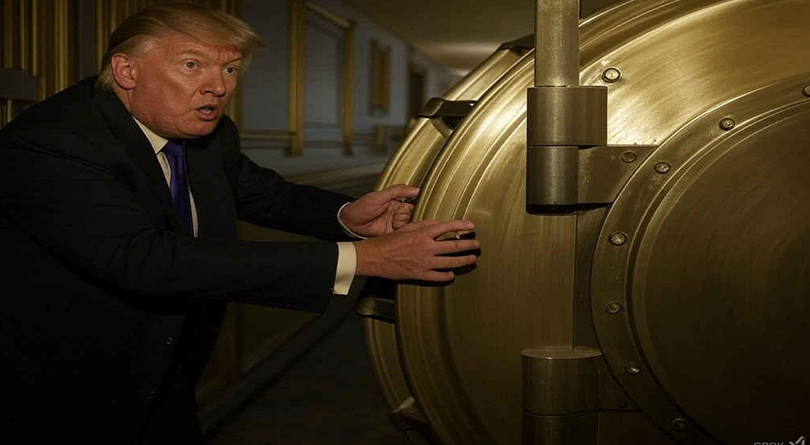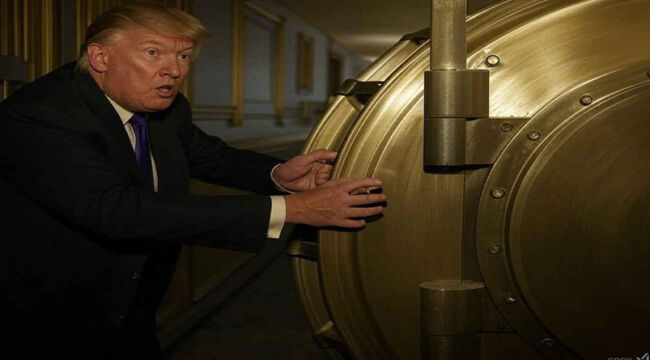Trump’s Fort Knox Knot
Speculation around the status of America’s gold reserves has reached a fever pitch.
At CPAC on Saturday President Trump once again shocked the world. He stated that he and Elon were going to Fort Knox to “see if the gold is still there.”
Then the President took things to another level:
Wouldn’t it be terrible if we opened it up and there was no gold there? So we’re gonna open those doors and if there’s tons of gold, we’ll be very happy.
Don’t be totally surprised if we open the door and say ‘there’s nothing here, they stole this too!’
We have a very corrupt group of people in this country and we’re finding them out.

Now I’m actually starting to get worried. Does Trump know something we don’t?
Why is President Trump making such a big issue of the gold audit before it has even begun? And who is this corrupt group of people he mentioned? The bullion banks? I honestly don’t know.
Is the upcoming Fort Knox audit related to the hundreds of tons of gold being flown into the U.S. every week from London and Switzerland?
Was too much of our gold “leased” out, as Jim Rickards suggested may have happened? If so, is it recoverable? Is it being shipped back as we speak?
For now, we have far more questions than answers. But we can speculate and prepare our own portfolios.
The Gold Bull Market Continues
Whether America’s gold reserves are intact or not, I strongly believe the bull market in precious metals will continue.
The fiat monetary system, which has been ascendent for the past 50 years, is finally giving up ground to gold.
Central banks around the world are stacking gold like they know something big is coming. A monetary reset of some sort.
A return to a gold standard is suddenly within the realm of possibility.
How High Can Gold Go?
Back in May of 2024, Jim Rickards penned an article titled $27,000 Gold. In it, he laid out the case that if the U.S. were to return to a gold standard, gold could rise to $27,000 per ounce.
It’s a fascinating argument. In the piece, Jim acknowledges that Western central bankers dislike gold, and given a choice, would never return to a gold standard. But what if they don’t have any other options?
Here’s Jim:
They have no interest in a form of money they can’t control. It took about 60 years from 1914–1974 to drive gold out of the monetary system. No central banker wants to let it back in.
Still, what if they have no choice? What if confidence in command currencies collapses due to some combination of excessive money creation, competition from Bitcoin, extreme levels of dollar debt, a new financial crisis, war or natural disaster?
In that case, central bankers may return to gold not because they want to, but because they must in order to restore order to the global monetary system.
Then Jim explained how he arrived at the $27,000 per ounce figure for gold:
U.S. M1 money supply is $17.9 trillion. (I use M1, which is a good proxy for everyday money)…
One needs to make an assumption about the percentage of gold backing for the money supply needed to maintain confidence. I assume 40% coverage with gold. (This was the legal requirement for the Fed from 1913–1946. Later it was 25%, then zero today).
Applying the 40% ratio to the $17.9 trillion money supply means that $7.2 trillion of gold is required.
Applying the $7.2 trillion valuation to 261.5 million troy ounces yields a gold price of $27,533 per ounce.
Jim’s hypothetical scenario has become highly relevant today. Recent developments indicate that we could indeed eventually return to a gold standard.
A return to the gold standard, of course, would require that America’s gold reserves are intact. If there is missing gold, I expect President Trump will remedy this and seize our gold back from wherever it disappeared to.
Perhaps that’s why President Trump is setting up this Fort Knox gold audit in such dramatic fashion. If there is missing metal, my guess is he plans to get it back, using any means necessary.
We’ll keep you updated on this developing story.



Comments: